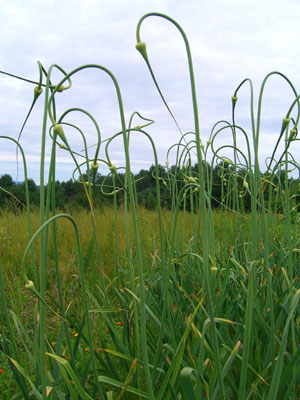Numen Resource Guide

photo by Sandra Lory
Garlic: An All-Star Winter Remedy
By Larken Bunce, MS, Clinical Herbalist & Co-Director Vermont Center for Integrative Herbalism, Montpelier, VT ©2009
Garlic (Allium sativum) is one of our most versatile medicines, providing respiratory, immune, digestive and cardiovascular support. Many excellent varieties grow happily and store well in a variety of climates and are readily available at farmer's markets. As a culinary herb, garlic is available in the produce aisle of coops and grocery stores and can be purchased with food stamps, making it a local, relatively inexpensive and widely available remedy.
Because garlic stimulates immune function and its volatile antimicrobial and mucus-thinning compounds are excreted partially through the lungs, it is especially valuable in preventing and resolving respiratory infections. As a broad-spectrum antimicrobial, garlic can also come in handy when stomach infections come around, as well as Strep infections of throat and ear and Staph infections (including resistant strains, e.g., MRSA). Garlic also increases circulation and sweating, helping to support the body's innate fever response. It's easy to see why garlic is a favorite for winter wellness.

photo by Sandra Lory
Fresh, cooked or aged? What's the difference?
Fresh garlic: powerful immune stimulant, broad-spectrum antimicrobial (acts on viruses, bacteria, fungi, protozoa and worms), diaphoretic (increases sweating), digestive antispasmodic, increases bile flow, expectorant, insect repellent
Gently cooked garlic: gently stimulates immune function (should be a regular part of winter diet); supports healthy intestinal flora and digestive health overall; supports cardiovascular health; provides support during cancer therapy and is cancer-preventive. Aged/encapsulated garlic products have similar benefits.
When to use garlic
- Cold and flu prevention and treatment
- Viral infections (respiratory or digestive, herpes simplex)
- Bacterial sinus and lung infections and congestion
- Gastrointestinal infections (esp. bacterial, parasitic or fungal)
- Vaginal infections
- Athlete's foot and other skin infections
- Moderately elevated blood pressure
- Moderately elevated cholesterol
- Elevated blood sugar
- Prevention of tumor growth
Make it yourself: Garlic-ginger oxymel
This is a favorite winter remedy that can be both used right away and stored for many months. Honey and vinegar add their own healing benefits. Can be used to prevent or address respiratory infection; encourages healthy fever and kills many common bacteria and viruses; also makes a good cough syrup, thinning mucus and encouraging expectoration. It's particularly nice for kids and sensitive adults because its sweetness tempers the heat of the ginger and garlic. Dose is 1 tablespoon 1–3x/day or as needed (higher dose for acute conditions); 1 teaspoon 1–3x/day for kids.
1 head garlic
4-inch piece of ginger root
2 tablespoons anise or fennel seeds
1 cup apple cider vinegar
1/2 cup local honey
Crush anise/fennel seeds in mortar and pestle; add to vinegar in a pot. Chop ginger and add to vinegar. Simmer mixture for 30 minutes. Remove from heat and add chopped garlic and honey. If there's time, allow to sit overnight before straining or leave ingredients combined and siphon off top as needed. (Garlic may turn blue-green over time—have no fear, this is part of a normal and safe chemical reaction between the garlic and vinegar.)
General dosing guidelines
- Start slow (with lower doses) and work up to avoid gastrointestinal side effects (see below).
- Many clinicians recommend 1 raw clove of garlic per day for prevention of colds and flus. Up to multiple bulbs per day have been recommended for therapeutic benefit. Use your judgment.
- Capsule doses vary based on method of preservation (aged/freeze-dried, etc.); a good brand is Garlicin—follow manufacturer's recommendations.
Garlic precautions
- Eating garlic while nursing can sometimes cause gastric upset for infants.
- You will have garlic breath and garlic sweat while using garlic therapeutically!
- High doses of raw garlic or garlic tincture can cause nausea or vomiting or other gastrointestinal upset in some individuals; mixing tincture or raw cloves with milk, honey or another fat or oil-based substance can help to reduce side effects.
Text development financially supported by the Herbalist in the Aisle program of Hunger Mountain Coop, Montpelier, VT.



